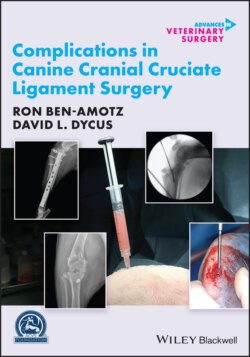Читать книгу Complications in Canine Cranial Cruciate Ligament Surgery - Ron Ben-Amotz - Страница 33
2.4.4 Implant Choices
ОглавлениеAs a variety of surgical procedures exist for stabilization of the CCL‐deficient stifle, a wide variety of implants also exist. Implants themselves have been significantly associated with the risk of developing a SSI [1]. When considering extracapsular stabilization techniques, suture types have included nylon fishing line, nylon leader line, ultra high molecular weight polyethylene (UHMWPE), and other multifilamented nonabsorbable suture materials [11, 12, 69]. Nylon has been shown to have reduced bacterial adherence compared to UHMWPE with variation in bacterial colonization of nylon between methods of sterilization [69]. In 1981, multifilamented nonabsorbable suture material used for extracapsular stabilization was reported to have an SSI rate of >21% [11]. In a more recent study using multifilamented UHMWPE, an SSI rate of 1.8% was reported [12]. The discrepancy in SSI rates may be due to improved sterilization and aseptic surgical techniques. Anecdotally, additional protective measures such as applying new sterile gloves prior to handling these materials may reduce the chances of bacterial colonization from skin contamination.
Figure 2.6 Example of a surgical safety checklist, based on the World Health Organization template found at www.who.int/patientsafety/topics/safe‐surgery/checklist/en/.
When considering proximal tibial osteotomy procedures, a variety of plates exist for stabilization of the osteotomy. Several studies have identified increased SSI risk associated with a variety of plates used specifically for TPLOs. Savicky et al. noted an increased SSI rate with Synthes plates whereas Thompson identified an increased SSI risk with Slocum implants [31, 34]. Solano et al. identified an increased risk associated with nonlocking plates compared to locking plates, whereas Giannetto found no significant difference in SSI rates between locking and nonlocking implants [28, 70]. Another study found no significant difference in SSI rates when comparing nonlocking plates, standard locking plates, and double locking plates used in animals >50 kg [19]. As many other factors contribute to the risk of developing an SSI, no one implant associated with TPLO has been shown to be superior at reducing this risk.
The majority of S. pseudintermedius isolates have been identified to be strong to moderate biofilm producers, with no difference between methicillin‐resistant and methicillin‐susceptible forms [71]. A biofilm is a sessile community of bacteria embedded in a self‐produced matrix which is adhered to a surface [72]. With the inherent ability to produce a biofilm, S. pseudintermedius can create an implant‐associated biofilm, making it more difficult for targeted antimicrobial treatment as minimum inhibitory concentrations are much higher for biofilm bacteria than planktonic bacteria [73]. As such, implant coatings such as silver have been assessed for their ability to resist biofilm formation. Silver‐coated implants are excellent at resisting MRSP biofilm formation in vitro, but in vivo evidence is not yet available in veterinary medicine [74]. Other implant coatings for biofilm prevention include heparin as an antiadhesive, chitosan as an antimicrobial, and hydroxyapatite which inhibits biofilm formation while encouraging bone growth [75]. None of these coated implants is used widely in veterinary medicine, nor are there reports of clinical use. Therefore, this may be an avenue for further clinical research as antimicrobial resistance becomes increasingly prevalent.
Figure 2.7 Following final skin preparation in the OR with the limb suspended, draping is performed by the sterile surgical team using a four‐quarter technique and top drape, with an optional iodinated incise film. (a) The cranial quarter drape is applied first. (b) A lateral quarter drape applied second. (c) The caudal quarter drape is applied next. (d) A sterile, nonpermeable dressing is used to grasp the nonsterile Vetrapped distal limb, while a nonsterile assistant cuts the tape suspending the limb. (e) While the sterile dressing is applied to the nonsterile distal limb, the final quarter drape is applied. (f) Sterile Vetrap is applied from proximal to distal around the sterile covered distal limb to adhere the sterile dressing in place. (g) Final sterile covering of the distal limb. (h) A top drape is applied over the four‐quarter drapes. (i) An iodinated incise film is applied to the skin. This step is optional. (j) Final appearance of draping.
